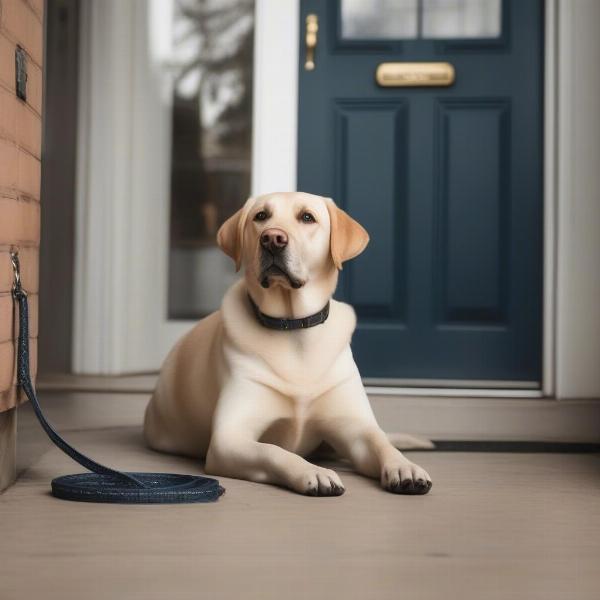The phrase “dog prayer” often evokes images of a sweet, soulful canine looking up with pleading eyes. While dogs may not pray in the human sense, understanding their behavior and needs is crucial to building a strong, loving bond. This article delves into interpreting your dog’s silent “prayers,” addressing their physical and emotional needs, and fostering a deeper connection with your furry friend.
Dogs communicate primarily through body language, vocalizations, and subtle cues. A whimper, a nudge with their nose, or a certain posture can all be forms of communication. Learning to decipher these signals is like understanding a dog’s prayer, unveiling their wants and needs. From a basic need for food and water to more complex desires for affection and playtime, recognizing these silent pleas helps us become better caregivers.
Decoding Your Dog’s Silent Prayers
Just like humans, dogs express their needs in various ways. Recognizing these signs is essential for responsible pet ownership. A dog’s “prayer” might be a whine at the door, signifying the need to go outside. It could be a persistent lick to your hand, a gentle request for attention or a treat. By paying attention to these subtle cues, we can address their needs promptly and effectively.
Recognizing Signs of Hunger and Thirst
Recognizing the signs of hunger and thirst is fundamental. While most dogs will readily eat when food is presented, some may be more subtle in their requests. Look out for pacing around their food bowl, licking their lips excessively, or even bringing you their empty bowl as a clear sign of their “prayer” for sustenance.
Identifying Play and Exercise Needs
Meeting your dog’s need for play and exercise is crucial for their physical and mental well-being. A bored dog can become destructive or develop behavioral issues. Observe for signs like bringing you their favorite toy, bouncing around excitedly, or even whining by the door, all of which can signify their desire for activity and stimulation.
 Dog ready for a walk
Dog ready for a walk
Responding to Your Dog’s Prayers
Understanding your dog’s communication is the first step. The next is responding effectively. This means providing fresh food and water, ensuring regular exercise, offering mental stimulation through training and play, and providing a safe, comfortable environment. It also involves providing regular veterinary care and addressing any health concerns promptly.
The Importance of Routine and Consistency
Establishing a regular routine is vital for a dog’s well-being. Consistent feeding times, walks, and play sessions provide stability and predictability, reducing anxiety and promoting a sense of security. Just like a prayer ritual provides comfort to humans, a consistent routine offers a similar sense of stability to dogs.
Building a Strong Bond Through Communication
Responding to your dog’s “prayers” builds trust and strengthens your bond. When your dog realizes that their communication is understood and acted upon, they develop a deeper sense of connection with you. This mutual understanding fosters a loving relationship built on respect and care.
A Prayer for Your Dog’s Well-being
While we can’t offer literal prayers for our dogs, we can strive to provide them with the best possible care. By understanding their needs, respecting their communication, and prioritizing their well-being, we can fulfill our roles as responsible and loving pet owners. This is the truest form of a “dog prayer” – a commitment to their health, happiness, and overall quality of life.
FAQ
- How can I tell if my dog is hungry? Look for signs like pacing around their food bowl, licking their lips excessively, or bringing you their empty bowl.
- What are some signs that my dog needs more exercise? Signs can include excessive barking, destructive behavior, restlessness, and bringing you their leash or favorite toy.
- How can I better understand my dog’s body language? Observe their posture, tail wags, ear position, and facial expressions. Many resources are available online and in books to help you learn more.
- Why is routine important for dogs? Routine provides stability and predictability, reducing anxiety and promoting a sense of security.
- What is the best way to build a strong bond with my dog? Spend quality time with your dog, engage in activities they enjoy, and respond consistently to their needs.
- How can I tell if my dog is in pain? Look for changes in behavior such as whining, limping, loss of appetite, or excessive licking of a particular area.
- What should I do if I’m struggling to understand my dog’s behavior? Consult a veterinarian or a professional dog trainer for guidance.
comfort dog prayer to owner
dog loss prayer
About ILM Dog
ILM Dog is your trusted international resource for all things dog-related. We offer expert advice on dog breeds, health, training, nutrition, grooming, and much more. Whether you’re a new dog owner or a seasoned pro, ILM Dog provides valuable insights and practical tips to help you navigate every stage of your dog’s life, from puppyhood to senior years. Contact us today for expert advice: Email: [email protected], Phone: +44 20-3965-8624.